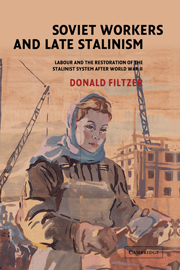 Soviet Workers and Late Stalinism
Soviet Workers and Late Stalinism Book contents
- Frontmatter
- Contents
- List of tables
- Preface and acknowledgements
- List of terms and abbreviations
- Introduction: the political imperatives of the postwar recovery
- 1 Rebuilding the workforce: free, slave, and indentured labour
- 2 The food crisis of 1946–1947
- 3 Attenuated recovery: the end of rationing, housing, and health
- 4 ‘Socializing’ the next generation: the position of young workers
- 5 Labour discipline and criminal law: the futility of repression
- 6 The industrial enterprise: working conditions, work organization, and wage determination
- Conclusion: labour and the ‘renormalization’ of Stalinist social relations
- Bibliography
- Index
1 - Rebuilding the workforce: free, slave, and indentured labour
Published online by Cambridge University Press: 07 August 2009
- Frontmatter
- Contents
- List of tables
- Preface and acknowledgements
- List of terms and abbreviations
- Introduction: the political imperatives of the postwar recovery
- 1 Rebuilding the workforce: free, slave, and indentured labour
- 2 The food crisis of 1946–1947
- 3 Attenuated recovery: the end of rationing, housing, and health
- 4 ‘Socializing’ the next generation: the position of young workers
- 5 Labour discipline and criminal law: the futility of repression
- 6 The industrial enterprise: working conditions, work organization, and wage determination
- Conclusion: labour and the ‘renormalization’ of Stalinist social relations
- Bibliography
- Index
Summary
The extent of the destruction the Soviet Union suffered in World War II is well known. Losses of plant and equipment, crops and livestock, housing stock, and population were on a truly massive scale. According to the most recent calculations by Mark Harrison, the war cost the Soviet Union some 25 per cent of its physical assets and approximately 14 per cent of its prewar population. In absolute terms, this meant the premature death of between 23.9 million and 26.6 million people, plus the emigration of 2.7 million people from the territories the USSR had seized in 1940. In this sense, as many historians have noted, the Soviet Union emerged from World War II as one of the defeated powers, not one of the victors. It is obvious that the process of recovery would be truly daunting. Destroyed assets – plant, equipment, housing stock, livestock, seed, and fields – had to be restored to use or replaced. Enterprises had to be converted from military to civilian production. Dislocated populations – at least those not in exile or labour camps – had to be resettled. Returning veterans had to be reintegrated into society and, more importantly from an economic point of view, into production. All this had to be done with a productive population which was far smaller in number, malnourished, and in worse health.
- Type
- Chapter
- Information
- Soviet Workers and Late StalinismLabour and the Restoration of the Stalinist System after World War II, pp. 13 - 40Publisher: Cambridge University PressPrint publication year: 2002


